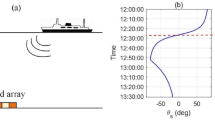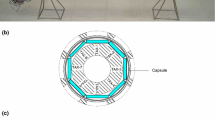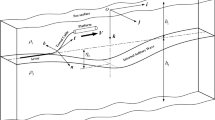Abstract
To obtain high-resolution of the subsurface structure, we modeled multi-depth slanted airgun sources to attenuate the source ghost. By firing the guns in sequence according to their relative depths, such a source can build constructive primaries and destructive ghosts. To evaluate the attenuation of ghosts, the normalized squared error of the spectrum of the actual vs the expected signature is computed. We used a typical 680 cu.in airgun string and found via simulations that a depth interval of 1 or 1.5 m between airguns is optimum when considering deghosting performance and operational feasibility. When more subarrays are combined, preliminary simulations are necessary to determine the optimum depth combination. The frequency notches introduced by the excess use of subarrays may negatively affect the deghosting performance. Two or three slanted subarrays can be combined to remove the ghost effect. The sequence combination may partly affect deghosting but this can be eliminated by matched filtering. Directivity comparison shows that a multi-depth slanted source can significantly attenuate the notches and widen the energy transmission stability area.
Similar content being viewed by others
References
Cambois, G., Long, A., Parkes, G., Lundsten, T., Mattsson, A., and Fromyr, E., 2009, Multi-level airgun array: a simple and effective way to enhance the low frequency content of marine seismic data: 79th Ann. Internat. Mtg, Soc. Expl. Geophys., Expanded Abstracts, 152–156.
Christie, P. A. F., Lunnon, Z. C., White, R. S., Kusznir N., Roberts, A. W., Parkin, C., Smith, L., Healy, D., Hurst, N., Tymms, V., Chappell, A., and Fletcher, R., 2006, iSIMM experience with peak- and bubble-tuned sources for generating low frequencies: 68th EAGE Annual International Meeting, Expanded Abstracts, A034.
Egan, M., George, K., Kasseh, E., and Moldoveanu, N., 2007, Full deghosting of OBC data with over/under source acquisition: 77th Ann. Internat. Mtg, Soc. Expl. Geophys., Expanded Abstracts, 31–35.
Halliday, D. F., 2013, Source-side deghosting: A comparison of approaches. 83rd Ann.Internat. Mtg, Soc. Expl. Geophys., Expanded Abstracts: 67–71.
Hegna, S., and Parkes, G. E., 2010, Method for acquiring and processing marine seismic data to extract and constructively use the up-going and down-going wavefields emitted by the source(s). EUO patent, No. EP2259091 A2.
Hegna, S., and Parkes, G., 2011, The low frequency output of marine air-gun arrays: 81st Ann. Internat. Mtg, Soc. Expl. Geophys., Expanded Abstracts, 77–81.
Hopperstad, J. F., Laws, R., and Kragh, E., 2008a, Fundamental principles of isotropic marine source design: 70th EAGEAnnual International Meeting, Expanded Abstracts, B025.
Hopperstad, J. F., Laws, R., and Kragh, E., 2008b, Where is the center of a multi-depth marine source array?: 78th Ann.Internat. Mtg, Soc. Expl. Geophys., Expanded Abstracts, 40–44.
Johnson, D. T., 1994. Understanding air-gun bubble behavior: Geophysics, 59, 1729–1734.
Landrø, M., 1992, Modelling of GI gun signatures: Geophysical Prospecting, 40, 721–747.
Laws, R. M., Hatton, L., and Haartsen, M., 1990, Computer modelling of clustered air-guns: First Break, 18(9), 331–338.
Li, X.. Wang, J., Zhang, J., and Du, X., 2013. Some seismic acquisition designs and key processing techniques and their testing effects in the deep water areas, South China Sea: China Offshore Oil and Gas (in Chinese), 25(6), 8–14.
Moldoveanu, N., 2000, Vertical source array in marine seismic exploration. 70th Ann.Internat. Mtg, Soc. Expl. Geophys., Expanded Abstracts, 53–56.
Parkes, G. E., and Hegna, S., 2011, How to influence the low frequency output of marine air-gun arrays: 73rd EAGE Annual International Conference and Exhibition, H012.
Payen, T., and Dowle, R., 2012, Compact broadband source and method: United States patent application, No. 2012/0287752A1.
Posthumus, B., 1993, Deghosting of twin streamer configuration. Geophysical Prospecting 41, 267–286.
Quan, H., Chen, X., Wei, X., Guo, Y., Luo, M., and Song, X., 2011, An analysis of the time-lapse explosion of airgun array in marine seismic. Oil Geophysical Prospecting (in Chinese), 46(4), 513–516.
Robertsson, J. O. A., Halliday, D., Manen, D. -J. van, Vasconcelos, I., Laws, R., Özdemir, K., and Grønaas, H., 2012, Full-wavefield, towed-marine seismic acquisition and applications. 74th EAGE Annual International Conference and Exhibition, Z015.
Robertsson, J. O. A., Manen, D. -J. van., Halliday. D., and Law, R., 2008, Seismic data acquisition and sourceside derivatives generation and applic:. Geophysical Prospecting, 24, 773–787.
Shen, H., Elboth, T., Tian, G., Warszawski, J., and Lilja, D., 2014, Theoretical study on multi-level source design: Geophysical Prospecting, 6, 1337–1352.
Shock, L., 1950, The progressive detonation of multiple charges in a single seismic shot. Geophysics 15, 208–218.
Smith, G. C., 1984, Three-dimensional air gun arrays: 54th Ann.Internat. Mtg, Soc. Expl. Geophys., Expanded Abstracts, 282–285.
Sønneland, L., and Berg, E., 1985, A new method for separating wave fields into up- and down-going components: 47th EAGE Annual International Meeting, Extended Abstracts, B-46.
Sønneland, L., Berg, E., Eidsvig, P., Haugen, B. F., and Vestby, J., 1986, 2D deghosting using vertical receiver arrays: 56th Ann.Internat. Mtg, Soc. Expl. Geophys., Expanded Abstract, 516–519.
Ziolkowski, A., 1970, A method for calculating the output pressure waveform from an air gun: Geophys. J. Roy. Astr. Soc. 21, 137–161.
Ziolkowski, A., 1998, Measurement of air-gun bubble oscillations: Geophysics, 63, 2009–2024.
Ziolkowski, A., Parkes, G., Hatton, L., and Haugland, T., 1982, The signature of an air-gun array-Computation from near-field measurements including interactions: Geophysics, 47, 1413–1421.
Author information
Authors and Affiliations
Corresponding author
Additional information
This research is financially supported by the national 863 program (2013AA064202) and Marine subject interdisciplinary and guidance fund of Zhejiang University (188040+193414Y01).
Shen Hong-Lei: See biography and photo in the Applied Geophysics January 2013 issue, P. 24.
Rights and permissions
About this article
Cite this article
Shen, HL., Elboth, T., Tian, G. et al. Modeling of multi-depth slanted airgun source for deghosting. Appl. Geophys. 11, 405–417 (2014). https://doi.org/10.1007/s11770-014-0461-1
Received:
Revised:
Published:
Issue Date:
DOI: https://doi.org/10.1007/s11770-014-0461-1




